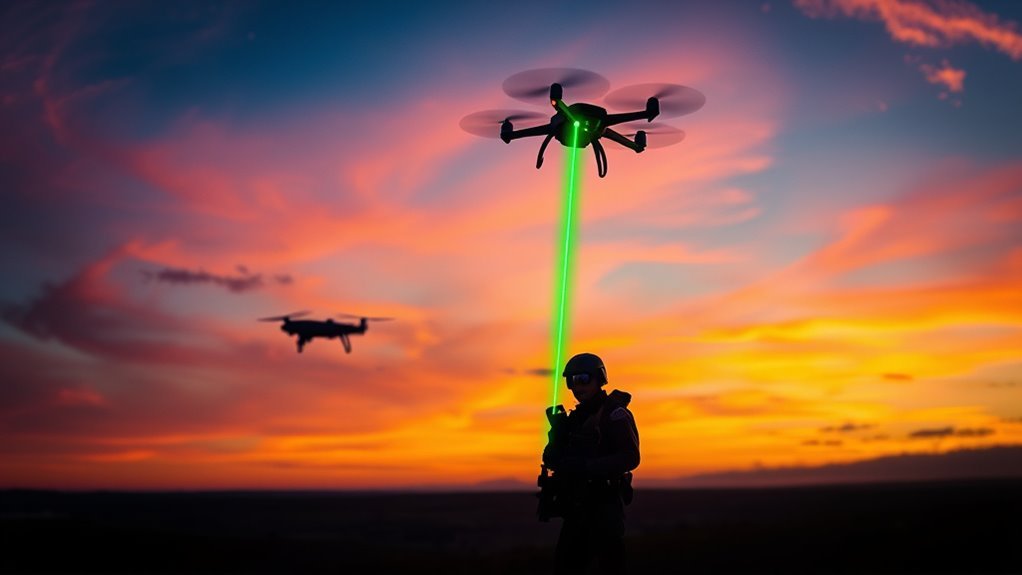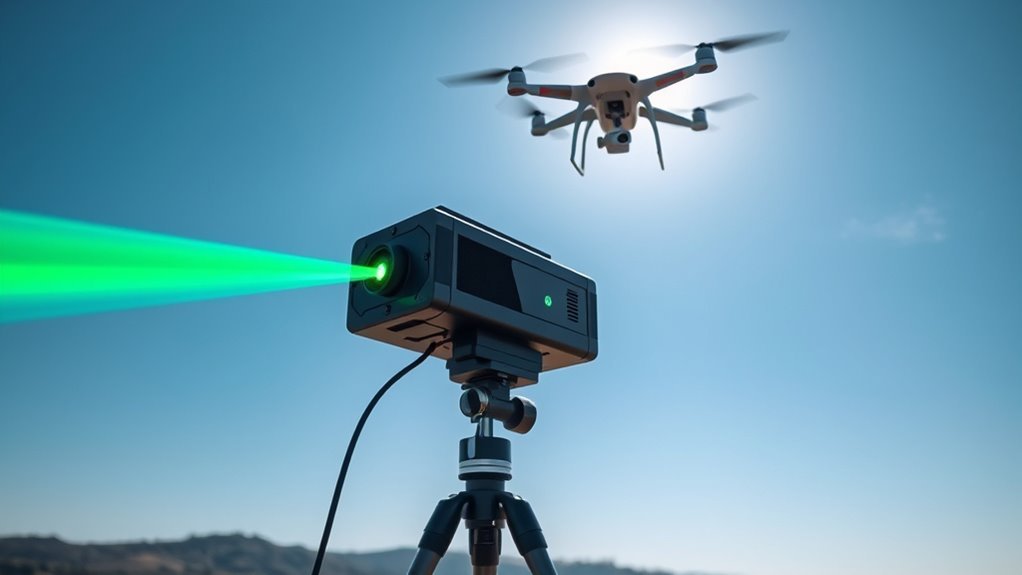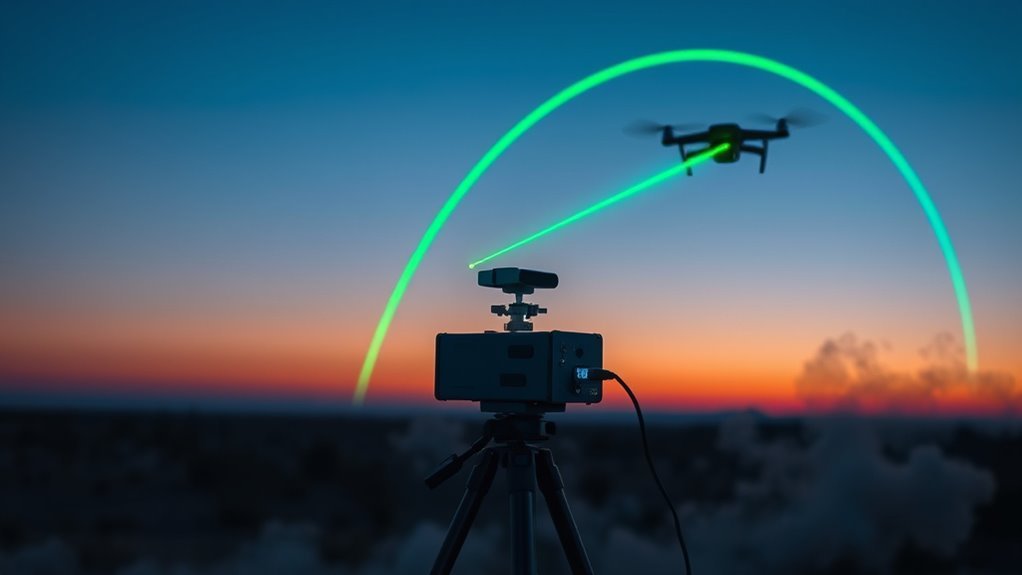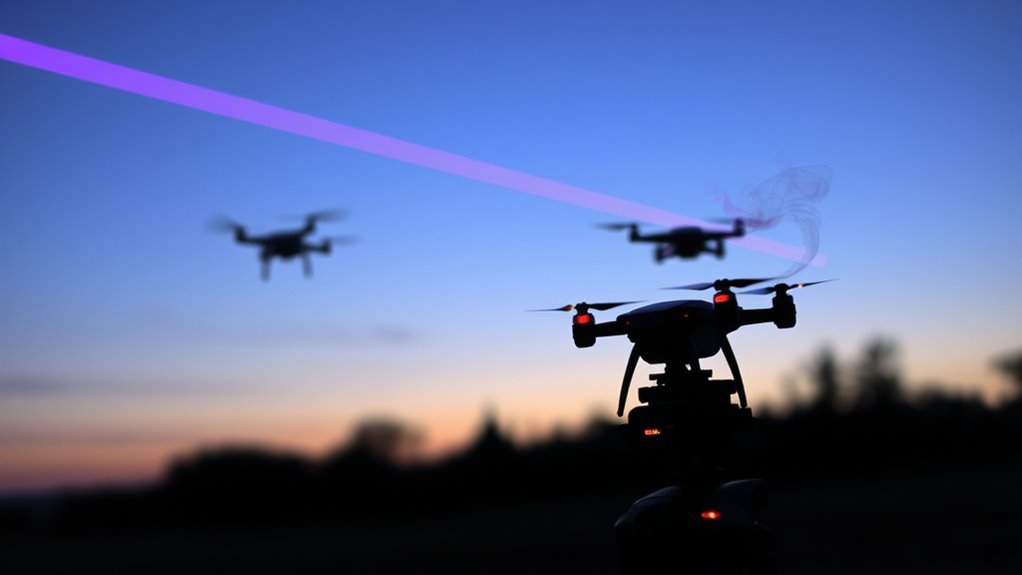To safely take down drones with lasers, you need to choose a suitable laser type—fiber or solid-state—ensuring compliance with legal regulations and safety standards. Precisely align and calibrate the laser equipment, targeting critical drone components while using real-time tracking for accuracy. Implement safety protocols like protective eyewear, controlled firing zones, and emergency contingencies to minimize collateral risks. Understanding these technical and regulatory factors sets the foundation for mastering effective and responsible drone neutralization methods.
Understanding Drone Technology and Laser Interaction

Although drones vary widely in design and function, understanding their core components—such as sensors, propulsion systems, and control circuits—is essential when considering laser interaction. You need to analyze how laser physics applies to these drone components. Lasers operate by delivering concentrated energy, which, when precisely targeted, can disrupt critical systems. Sensors, often optical or infrared, may be vulnerable to laser-induced blindness or damage, impairing navigation. Propulsion systems, typically electric motors, can be overheated or physically damaged by sustained laser exposure. Control circuits, containing sensitive electronics, risk malfunction from thermal stress or direct photonic interference. By grasping these technical interactions, you can strategize effective, non-destructive countermeasures that respect your operational freedom while neutralizing unauthorized drones. This analytical approach is crucial for safe, efficient drone mitigation using laser technology.
Types of Lasers Suitable for Drone Mitigation

When choosing lasers for drone mitigation, you’ll need to take into account high-powered options like fiber and solid-state lasers for effective disruption. Each laser type has specific operational characteristics that impact range, power consumption, and target engagement. Additionally, you must account for safety protocols and regulatory limits to guarantee compliant and responsible deployment.
High-Powered Laser Options
Since drones often operate at varying altitudes and speeds, selecting the appropriate high-powered laser for mitigation requires careful consideration of factors such as wavelength, beam quality, and power output. You’ll want to evaluate laser specifications meticulously to maximize effectiveness while maintaining operational freedom. Key high powered options include:
- Fiber lasers: Offer high beam quality and efficiency, ideal for long-range engagement.
- Solid-state lasers: Provide robust power output with compact form factors.
- CO2 lasers: Emit longer wavelengths, useful for specific material interactions on drone surfaces.
Each type presents unique advantages depending on your tactical needs. Understanding these laser specifications helps you choose a system capable of reliably disabling drones without compromising precision or safety. This analytical approach guarantees you maintain control while defending your airspace effectively.
Safety and Regulatory Considerations
Because deploying lasers for drone mitigation involves inherent risks, you need to prioritize safety protocols and adhere strictly to regulatory frameworks. Selecting the right laser type—typically solid-state or fiber lasers with controlled output power—ensures compliance with safety standards while maintaining effective neutralization. Regulatory compliance requires that your system limits unintended exposure to bystanders and avoids interference with aviation operations. Implementing beam control mechanisms and fail-safes reduces hazards associated with high-powered emissions. You must also verify that your laser device meets local and federal regulations governing directed energy use. By aligning your mitigation strategy with established safety standards, you safeguard both public welfare and your operational freedom, enabling responsible drone countermeasures without legal or ethical compromise.
Legal Considerations and Regulations for Using Lasers Against Drones

Although lasers offer a precise method for disabling drones, you must navigate complex legal frameworks that govern their use. Understanding drone regulations is vital to guarantee your actions remain lawful and don’t infringe on others’ rights. Before engaging, consider:
- Federal and local laws regulating the deployment of laser technology against aerial vehicles
- Restrictions on interfering with navigable airspace and privacy protections
- Liability risks associated with collateral damage or unintended consequences
Legal frameworks vary widely, so you should consult relevant statutes and possibly seek legal counsel. Using lasers against drones without proper authorization can result in severe penalties, including fines or criminal charges. By respecting these regulations, you safeguard your freedom while responsibly managing drone threats.
Safety Precautions When Deploying Laser Systems
When you deploy laser systems against drones, guaranteeing strict adherence to safety protocols is essential to prevent harm to bystanders, operators, and unintended targets. Prioritize laser safety by confirming that your operational environment is secure, with restricted access to non-essential personnel. Use appropriate protective eyewear and guarantee all operators are trained in recognized operational guidelines to minimize accidental exposure. Establish clear firing zones and maintain situational awareness to prevent laser beams from intersecting with reflective surfaces or unauthorized objects. Continuously monitor system performance and environmental conditions to adapt safety measures dynamically. By rigorously following these laser safety protocols and operational guidelines, you preserve freedom while responsibly mitigating risks, guaranteeing your laser deployment neutralizes drones effectively without compromising public or personal safety.
Effective Laser Targeting Techniques for Drone Disabling
To disable drones effectively using laser systems, you need to focus on precise targeting to maximize energy delivery while minimizing collateral damage. Mastering laser precision techniques is essential, and integrating advanced drone tracking methods enhances your control. You should:
- Utilize real-time tracking algorithms to predict drone trajectories accurately, ensuring laser alignment remains stable.
- Employ adaptive optics to compensate for atmospheric disturbances, maintaining beam focus on the target.
- Synchronize laser pulses with drone movement to concentrate energy efficiently, disrupting critical components swiftly.
Potential Risks and How to Minimize Collateral Damage
You need to carefully assess environmental hazards to avoid unintended damage when disabling drones. Preventing targeting errors requires precise identification systems and controlled engagement zones. Implementing strict safety protocols guarantees both operator security and minimizes collateral impact.
Assessing Environmental Hazards
Although taking down a drone might seem straightforward, failing to assess environmental hazards can lead to significant unintended consequences. You need to evaluate the environmental impact carefully, particularly how laser use might affect surrounding flora and fauna. Wildlife safety must be a priority to maintain ecological balance and avoid harm to animals. Before engaging:
- Analyze the terrain and vegetation density to predict laser diffusion and fire risk.
- Consider wind conditions that could carry debris or ignite materials.
- Identify nearby wildlife habitats to prevent disturbance or injury from laser reflections or falling debris.
Preventing Unintended Targets
Environmental assessments only scratch the surface of safe drone takedown operations; preventing unintended targets demands equal attention. You must refine target identification algorithms to avoid unintended consequences, including collateral damage to bystanders or property. Precise laser calibration and real-time monitoring reduce risks. Understanding the operational environment’s complexity is essential for minimizing collateral impact.
| Risk Factor | Mitigation Strategy |
|---|---|
| Misidentification | Enhanced sensor fusion |
| Reflective surfaces | Adjust laser angle and power |
| Nearby aircraft | Establish no-fly zones |
| Weather interference | Employ adaptive targeting |
| Human presence | Real-time surveillance and alerts |
Implementing Safety Protocols
When implementing safety protocols for drone takedown operations, understanding potential risks is essential to minimizing collateral damage. You must prioritize safety training and protocol development to guarantee precise, controlled engagements. Key considerations include:
- Target verification: Confirm drone identity and trajectory to avoid unintended hits.
- Environmental assessment: Analyze surroundings for bystanders, property, and reflective surfaces that may amplify laser risks.
- Emergency contingencies: Establish procedures for malfunction or misfire to mitigate hazards immediately.
Equipment Setup and Calibration for Optimal Performance
Since accurate equipment setup and calibration directly impact your drone takedown success, you need to follow a systematic process. Begin with precise equipment calibration, ensuring each component functions within manufacturer specifications. Use diagnostic tools to verify laser output power and beam quality. Next, perform meticulous laser alignment to guarantee the beam path targets the drone’s critical components without deviation. Align the optical elements in a controlled environment, minimizing external disturbances. Check alignment regularly to compensate for mechanical shifts or thermal expansion. Incorporate automated calibration routines where possible to maintain consistent performance. Remember, flawless setup maximizes your system’s efficacy while preserving operational freedom. By prioritizing exact calibration and alignment, you reduce risks of collateral damage and enhance the reliability of your laser drone defense system, empowering you to maintain control with confidence and precision.
Real-World Applications and Case Studies of Laser Drone Defense
Real-world deployments of laser drone defense systems demonstrate their effectiveness in diverse operational environments. If you want to safeguard critical assets or maintain airspace freedom, these systems have proven their value across multiple domains. You’ll find laser technology increasingly integrated into both military applications and commercial uses, offering precise, non-kinetic neutralization of unauthorized drones without collateral damage.
Consider these key case studies:
- Military bases employing lasers to intercept surveillance and attack drones, ensuring perimeter security.
- Airports using laser defense to prevent drone incursions that disrupt air traffic and compromise safety.
- Industrial facilities protecting sensitive infrastructure from espionage or sabotage via commercial laser systems.
Alternatives and Complementary Methods to Laser Drone Mitigation
Although laser systems offer precise drone neutralization, relying solely on them may not address every threat scenario or operational constraint. To maximize operational freedom and flexibility, you should consider integrating alternatives like drone jamming and net capture. Drone jamming disrupts a drone’s communication and GPS signals, effectively disabling its control without physical damage, which is ideal in congested or sensitive environments. Net capture systems physically restrain drones mid-flight using projectile nets, allowing for safe recovery and forensic analysis. These complementary methods can fill gaps where lasers might be limited by weather conditions, range, or power availability. By combining laser mitigation with drone jamming and net capture, you can establish a versatile, layered defense strategy that upholds both security and operational freedom.

